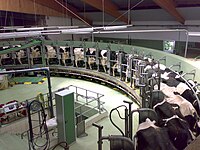
Photo from wikipedia
Abstract Ruminal acidosis can penalize cattle performance and modify ruminal microbiota composition; in that sense, providing quality forage may be a useful tool to cope with such dysfunction. This assay… Click to show full abstract
Abstract Ruminal acidosis can penalize cattle performance and modify ruminal microbiota composition; in that sense, providing quality forage may be a useful tool to cope with such dysfunction. This assay aimed to control animals’ performance and assess ruminal microbiota shifts and interactions when fattening Holstein bulls are fed corn-based concentrate and different quality forages. Thirty animals (from 119 to 332 d of age and from 164 to 511 kg body weight [BW]) were fed corn-based concentrate and were allotted to three experimental treatments or forage sources: barley straw, considered as control (Hordeum vulgare, CTR), oats haylage (Avena sativa, OATS) or vetch haylage (Vicia sativa, VETCH). Both concentrate and forage were supplied ad libitum in a free choice system and animals had free access to drinking water. Bulls’ BW and concentrate intake were automatically recorded on a daily basis. Feces and ruminal fluid were sampled twice, during the growing period (158 d of age and 220 kg BW) and during the finishing period (280 d of age and 434 kg BW), for digestibility, ruminal fermentation and microbial population characterization. No differences in concentrate intake or BW could be detected between CTR and OATS-fed animals; however, VETCH-fed bulls had lower concentrate intake (P
Journal Title: Animal Feed Science and Technology
Year Published: 2020
Link to full text (if available)
Share on Social Media: Sign Up to like & get
recommendations!